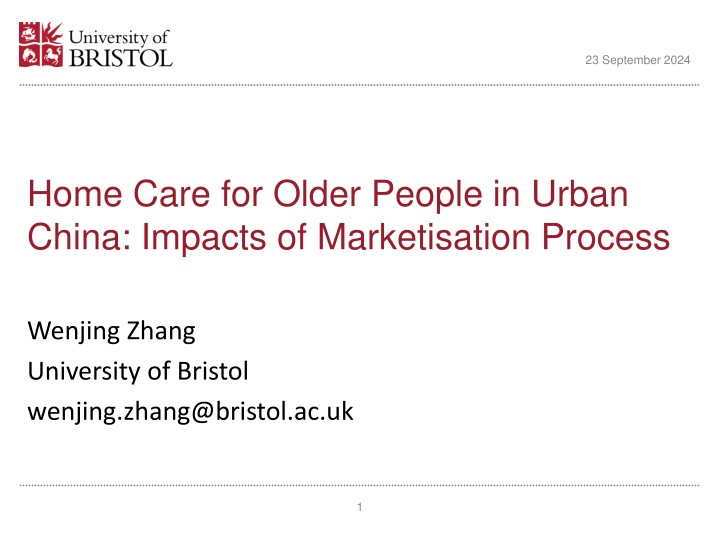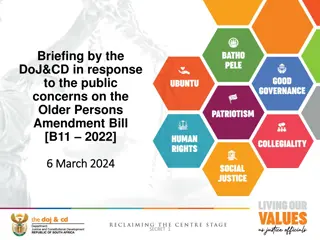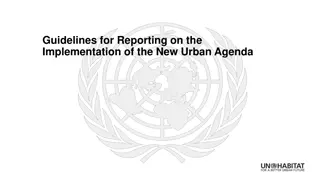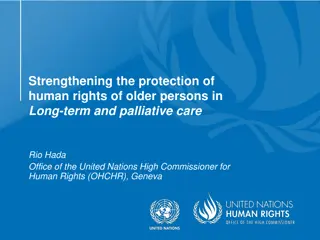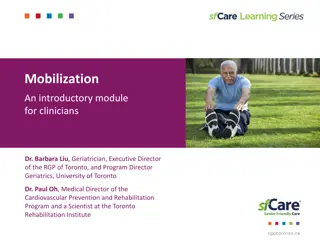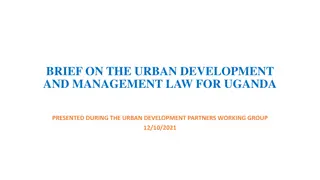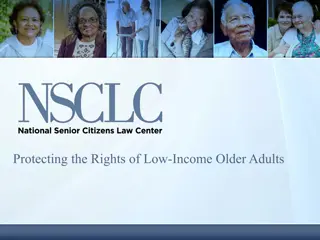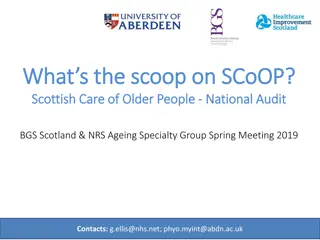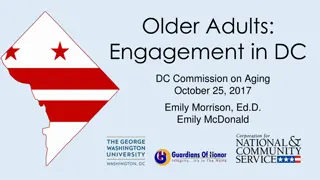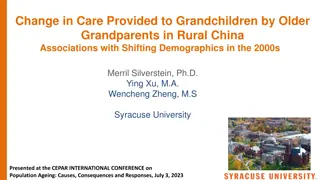Impacts of Marketisation on Home Care for Older People in Urban China
This study by Wenjing Zhang from the University of Bristol delves into the effects of the marketisation process on home care for the elderly in urban China. It explores the rationale behind the marketisation of care, the trends in home care marketisation, and the processes involved. The background section highlights the disparities between rural and urban home care provisions in China, citing demographic changes and policy implications. The study also differentiates between care systems in urban and rural China, emphasizing the rapid development of home care in urban areas. The theoretical framework examines the concept of marketisation of care, emphasizing its application and international convergences. By shedding light on these aspects, the research aims to provide insights into the evolving landscape of elder care in urban China.
Download Presentation

Please find below an Image/Link to download the presentation.
The content on the website is provided AS IS for your information and personal use only. It may not be sold, licensed, or shared on other websites without obtaining consent from the author.If you encounter any issues during the download, it is possible that the publisher has removed the file from their server.
You are allowed to download the files provided on this website for personal or commercial use, subject to the condition that they are used lawfully. All files are the property of their respective owners.
The content on the website is provided AS IS for your information and personal use only. It may not be sold, licensed, or shared on other websites without obtaining consent from the author.
E N D
Presentation Transcript
23 September 2024 Home Care for Older People in Urban China: Impacts of Marketisation Process Wenjing Zhang University of Bristol wenjing.zhang@bristol.ac.uk 1
23 September 2024 Outline Aims Background Theoretical framework Methods Findings 2
23 September 2024 Aims To explore impacts of marketisation of home care in urban China Rationale behind the marketisation of care Marketisation trend of home care Processes of marketisation of home care 3
23 September 2024 Background Care policy and provision for older people in China Home care in China Rural vs urban disparities 4
23 September 2024 Care policy and provision for older people in China Dramatic demographic changes rapid ageing (65+, 10.1%, 2014) one child policy decreasing household size from 4.43 in 1964 to 3.02 in 2014 Social-economic reforms e.g. labour market, housing marketisation, migration Increasing old-age dependency challenges the family-centred care provision Source: United Nations, Department of Economic and Social Affairs, Population Division (2015). 5
23 September 2024 Home care Home care is the foundation of the Chinese elder care system, combining community care and residential care (Ministry of Civil Affairs in China, 2010) e.g. 9064 in Beijing; 9073 in Shanghai; 9055 in Wuhan Definition: services provided at older people s homes by care workers or a mix of care workers and family members personal care (e.g. nursing), practical care (e.g. cooking, shopping, cleaning), emotional support 6
23 September 2024 Different care systems in urban and rural China Different ageing paths and double-track elder care system Over 20% aged 60 and older in cities like Beijing, Shanghai, Suzhou (national 14.9%, 2014). Fewer adult children due to the stricter one child policy in urban China (Zhan, 2013). Urban residents have more access to resources from the state and market Extensive marketisation in urban China since 1990s e.g. housing, education, welfare. Development of home care in urban areas is more rapid than in rural China 7
23 September 2024 Theoretical framework: marketisation of care Definition: the application of markets, market principles, and market mechanisms in the field of social care Embedded convergences at international level Different paths/characteristics 8
23 September 2024 Home care market Qualitative approach Fieldwork Shanghai forefront of marketisation Stakeholders service users, providers, purchasers, care workers, regulators. 30 Interviews 21 care agency managers; 9 public officials Policy documents purch aser provid er user/ carer Service providers & local regulators (purchasers) 9
23 September 2024 Context of Shanghai in China, 2014 China Shanghai Ageing population (65+) 137,550,000 10.1% 2,566,300 17.9% GDP per capita RMB 47,203 ( 4,720) RMB 97,370 ( 9,737) Marketisation level1 6.56 9.78 (Rank 2 of 31 provinces) Urbanization rate 56% 90% Note: 1. Marketisation level is measured by indicators of the relationship between the state and the market, non-state-owned economy, factor market, product market, and market intermediaries and legal environment (Fan, et al., 2015). Source: National Bureau of Statistics of China, National Economic Research Institute, China Reform Foundation; Shanghai Research Centre of Ageing 10
23 September 2024 Sampling criteria Categories Sub-categories Groups Higher managers in charge of agencies Managers in service sector Managers in marketing sector Care manager and care worker Number 8 Managers 9 Service providers 3 Staff in local stations 2 Public officials in sub- district (jiedao) level Public officials in community (shequ/juwei) level Public officials / local administrative in the field of care for older people 5 4 11
23 September 2024 Geographical coverage of agencies more than 1 city in China, 3 less than 1 district in Shanghai, 3 less than 1 district in Shanghai 1-3 districts in Shanghai 4 or more districts in Shanghai more than 1 city in China 4 or more districts in Shanghai, 1 1-3 districts in Shanghai, 6 12
23 September 2024 Findings Home care: based on persistent culture value of filial piety Shifting balance of care diamond in urban China Quasi-market in urban China 13
23 September 2024 Home care: based on persistent culture value of filial piety Cultural norms Family Preference of older people and their family Objective constraints Familial care cannot cover Institutional/community care are not enough 14
Service Care diamond Shifting balance of state, market, family and community in the field of care for older people Financing Regulation Mixed economy of care Financing for older people in urban China Service provision for older people in urban China Elder care diamond in China Source: Ochiai (2009)
23 September 2024 Quasi-market in urban China Quasi-market (Le Grand, 1991) Market: competitive independent agencies replacing the monopolistic state providers Differences to conventional markets: not-for-profit and/or for-profit organisations competing for public contracts vouchers involved for purchasing the consumers represented in the market by agents 16
23 September 2024 Processes of marketization of care in urban China Contracting out Service provision programs, care agencies Financial support from the state e.g. subsidy programs to older people, care workers. from directly allocated to providers to purchasing through a bidding process Direct purchasing through private funding 17
23 September 2024 Prospects of quasi-market in urban China Market: care demands are not fully expressed, seize market share In theory: disable prevalence ratio of 65+, 80+. In practice consumption attitudes of Chinese people (older generation) purchasing power of older generation State Paternal responsibilities persistent financial & policy support, guiding service consumption, regulating Debates: protecting vulnerable VS marketisation 18
23 September 2024 Thank you! wenjing.zhang@bristol.ac.uk 19
